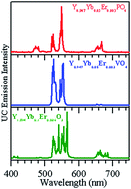Host matrix impact on Er3+ upconversion emission and its temperature dependence†
Abstract
By synthesizing Y(1.9−2x)Yb0.1Er2xO3, Y(0.95−x)Yb0.05ErxVO4 and Y(0.95−x)Yb0.05ErxPO4 phosphors, with phonon frequency maxima at 560, 826 and 1050 cm−1, respectively, we present the impact of phonon energy and crystal structure of the host matrix on upconversion and temperature sensing behavior. The spectral upconversion characteristics of all three phosphors reveal noticeable differences. The temperature sensing studies reveal that the phosphors have maximum sensitivity at ∼490 K, which is found to be highest (0.0105 K−1) in Y0.947Yb0.05Er0.003VO4 followed by Y1.894Yb0.1Er0.006O3 and Y0.947Yb0.05Er0.003PO4 phosphors. We found that the temperature sensitivity basically depends on the intensity ratio of two thermally coupled emission bands, 2H11/2 → 4I15/2 and 4S3/2 → 4I15/2, of Er3+. Further, the intensity ratio depends on phonon energy of the host lattice, crystal structure, surface quenching centers and the temperature dependence of non-radiative decay rate.


 Please wait while we load your content...
Please wait while we load your content...